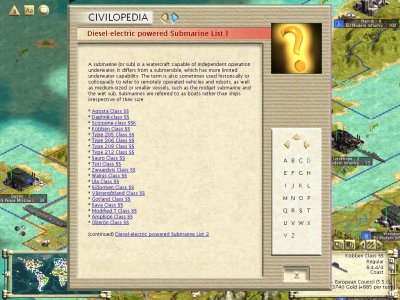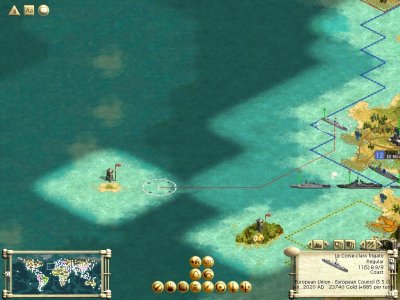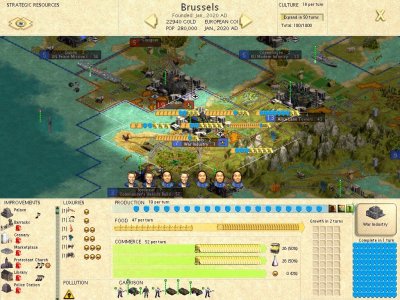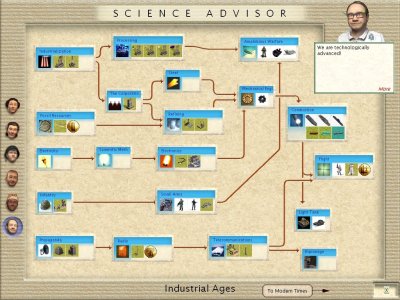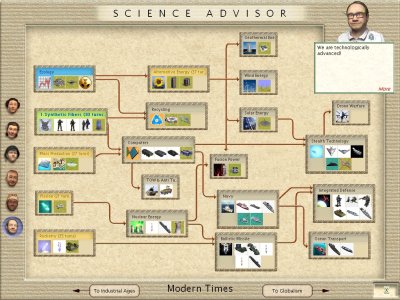You are using an out of date browser. It may not display this or other websites correctly.
You should upgrade or use an alternative browser.
You should upgrade or use an alternative browser.
[MOD] Earth Globalism Mod II
- Thread starter unartis
- Start date
unartis
King
EGMII 1.14 beta is available!
The EGMII 1.14 game mod was added with 344 sea units, which were grouped according to different types. From the transport units, through the coastal guard units, from Corvette, frigate, destroyers to the guide- or cruises-missile attacks type ships. Submarines is also in this game mode. Dizel-electric-type attack submarines and nuclear-powered attack submarines ranging from Submarines to take nuclear charge.
The EGMII 1.14 game mod was added with 344 sea units, which were grouped according to different types. From the transport units, through the coastal guard units, from Corvette, frigate, destroyers to the guide- or cruises-missile attacks type ships. Submarines is also in this game mode. Dizel-electric-type attack submarines and nuclear-powered attack submarines ranging from Submarines to take nuclear charge.
Attachments
Last edited:
unartis
King
Hi All,
The EGMII version 1.15, which will contain air units. I put units used and built after World War II in this accessory. Now, I compiled and grouped air units according to their type and use. I collect units that are recently used and actually used in the present. I will group is organized by their speed, Mach number, along with their type.
I encountered a little problem that I can't find any data about this aircraft: Canadair CL-10 Fury Mk.I (RCN)


This type is similar to that: Lockheed P-80 Shooting Star, T–33 Shooting Star (Lockheed T-33)

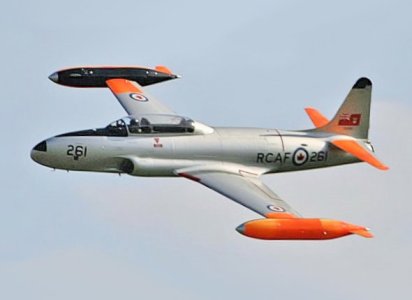
Do you think?
The EGMII version 1.15, which will contain air units. I put units used and built after World War II in this accessory. Now, I compiled and grouped air units according to their type and use. I collect units that are recently used and actually used in the present. I will group is organized by their speed, Mach number, along with their type.
I encountered a little problem that I can't find any data about this aircraft: Canadair CL-10 Fury Mk.I (RCN)


This type is similar to that: Lockheed P-80 Shooting Star, T–33 Shooting Star (Lockheed T-33)


Do you think?
- Joined
- May 5, 2005
- Messages
- 10,309
As this aircraft is neither in the list of aircraft of Canada's air forces nor in the list of of the Royal Canadian Navy (RCN) my guess is, that this is one of Top Gun´s fantasy aircraft. As it looks very similar to the North American FJ-1 Fury, and even has the "Fury" in its (fantasy) name, I would use the technical datas of that aircraft.
unartis
King
As this aircraft is neither in the list of aircraft of Canada's air forces nor in the list of of the Royal Canadian Navy (RCN) my guess is, that this is one of Top Gun´s fantasy aircraft. As it looks very similar to the North American FJ-1 Fury, and even has the "Fury" in its (fantasy) name, I would use the technical datas of that aircraft.
Thank you,

I will save it under this name as an option for later selection
timerover51
Deity
It was based on the original straight-winged version of the F-86 Sabre and the FJ-2 Fury used by the U.S. Navy. Only 3 were ever built as it lacked the required performance and also access to German data on swept wings lead the U.S. to go with a swept wing version which significantly improved performance. The Canadians built a lot of F-86 Sabres as well. This is strictly a fantasy aircraft.Hi All,
The EGMII version 1.15, which will contain air units. I put units used and built after World War II in this accessory. Now, I compiled and grouped air units according to their type and use. I collect units that are recently used and actually used in the present. I will group is organized by their speed, Mach number, along with their type.
I encountered a little problem that I can't find any data about this aircraft: Canadair CL-10 Fury Mk.I RCN)
Last edited:
unartis
King
ThanksIt was based on the original straight-winged version of the F-86 Sabre and the FJ-2 Fury used by the U.S. Navy. Only 3 were ever built as it lacked the required performance and also access to German data on swept wings lead the U.S. to go with a swept wing version which significantly improved performance. The Canadians built a lot of F-86 Sabres as well. This is strictly a fantasy aircraft.
 ,
,then I won't take it seriously if it's just a fantasy
unartis
King
EGMII 1.15 will include helicopter(transport, attack), Turboprop and Jet powered aircraft units(transport, fighter, etc) and stealth aircraft units and UAV
I am in the process of organizing the units. I group Jet powered aircraft according to their speed. Considering the Mach number:
Mach number:
speed:.....................................................................................................
Subsonic= <0.8 (Mach); <609 (mph); <980 (km/h)
transonic= 0.8–1.2 (Mach); 609–914 (mph); 980–1,470 (km/h)
supersonic= 1.2–5.0 (Mach); 915–3,806 (mph); 1,470–6,126 (km/h)
hipersonic=5.0–10.0 (Mach);3,806–7,680 (mph); 6,126–12,251 (km/h)
The mach number in the game will control the size of the operating space, so a transonic type JET will have a smaller operating space than a supersonic type JET.
 It's incredible how much you can learn while editing based on the flight description.
It's incredible how much you can learn while editing based on the flight description.
I am in the process of organizing the units. I group Jet powered aircraft according to their speed. Considering the Mach number:
Mach number:
speed:.....................................................................................................
Subsonic= <0.8 (Mach); <609 (mph); <980 (km/h)
transonic= 0.8–1.2 (Mach); 609–914 (mph); 980–1,470 (km/h)
supersonic= 1.2–5.0 (Mach); 915–3,806 (mph); 1,470–6,126 (km/h)
hipersonic=5.0–10.0 (Mach);3,806–7,680 (mph); 6,126–12,251 (km/h)
The mach number in the game will control the size of the operating space, so a transonic type JET will have a smaller operating space than a supersonic type JET.
 It's incredible how much you can learn while editing based on the flight description.
It's incredible how much you can learn while editing based on the flight description.- Joined
- May 5, 2005
- Messages
- 10,309
I don´t think that the mach number is a good scale for combat range. If a plane is faster, it mostly consumes more fuel. A good scale for combat range in my eyes - well - would be combat range.EGMII 1.15 will include helicopter(transport, attack), Turboprop and Jet powered aircraft units(transport, fighter, etc) and stealth aircraft units and UAV
I am in the process of organizing the units. I group Jet powered aircraft according to their speed. Considering the Mach number:
Mach number:
speed:.....................................................................................................
Subsonic= <0.8 (Mach); <609 (mph); <980 (km/h)
transonic= 0.8–1.2 (Mach); 609–914 (mph); 980–1,470 (km/h)
supersonic= 1.2–5.0 (Mach); 915–3,806 (mph); 1,470–6,126 (km/h)
hipersonic=5.0–10.0 (Mach);3,806–7,680 (mph); 6,126–12,251 (km/h)
The mach number in the game will control the size of the operating space, so a transonic type JET will have a smaller operating space than a supersonic type JET.
It's incredible how much you can learn while editing based on the flight description.
 I used that scale in CCM for the range of all classes of aircraft.
I used that scale in CCM for the range of all classes of aircraft.unartis
King
Civinator thanks,I don´t think that the mach number is a good scale for combat range. If a plane is faster, it mostly consumes more fuel. A good scale for combat range in my eyes - well - would be combat range.I used that scale in CCM for the range of all classes of aircraft.
What you wrote is a good idea, it's worth introducing combat distance, but it seems like both are the same because greater distance also means greater fuel consumption.
The Mach number obviously increases the combat distance and the differences in the armament of earlier JET powered aircraft and newer JETs increase their variability.
There are countries that don't mind using much more fuel because they have such reserves. By variety here I mean the combination of weapon efficiency and speed, which means greater distance. I want to test how the difference in unit speed (which is reflected in distance) and weaponry creates interesting situations in the game.
 If what I'm planning doesn't work, I'll consider what you used in CCM.
If what I'm planning doesn't work, I'll consider what you used in CCM.unartis
King
@Civinator
Another thing... My question is, did you use the Cross-Platform Editor for CCM and did you utilize its capabilities?
Another thing... My question is, did you use the Cross-Platform Editor for CCM and did you utilize its capabilities?
timerover51
Deity
Going over the speed of sound or Mach 1, increases your fuel consumption drastically, more than doubling it depending on the engine, while more power does not lead to a corresponding range increase. At Mach 2 you may be burning 4 times the amount of fuel per minute as you would below Mach 1. Once a jet dogfight starts, speed drops to below Mach 1. Combat range is the best judge of combat distance.Civinator thanks,
What you wrote is a good idea, it's worth introducing combat distance, but it seems like both are the same because greater distance also means greater fuel consumption.
The Mach number obviously increases the combat distance and the differences in the armament of earlier JET powered aircraft and newer JETs increase their variability.
There are countries that don't mind using much more fuel because they have such reserves. By variety here I mean the combination of weapon efficiency and speed, which means greater distance. I want to test how the difference in unit speed (which is reflected in distance) and weaponry creates interesting situations in the game.
If what I'm planning doesn't work, I'll consider what you used in CCM.
- Joined
- May 5, 2005
- Messages
- 10,309
Yes, CCM 2 and 3 were created by using the Quintillus editor. Especially the values for cultural victory in CCM are far beyond the limits of the Firaxis editors.@Civinator
Another thing... My question is, did you use the Cross-Platform Editor for CCM and did you utilize its capabilities?
unartis
King
Going over the speed of sound or Mach 1, increases your fuel consumption drastically, more than doubling it depending on the engine, while more power does not lead to a corresponding range increase. At Mach 2 you may be burning 4 times the amount of fuel per minute as you would below Mach 1. Once a jet dogfight starts, speed drops to below Mach 1. Combat range is the best judge of combat distance.
Thanks,
Very good arguments

unartis
King
Yes, CCM 2 and 3 were created by using the Quintillus editor. Especially the values for cultural victory in CCM are far beyond the limits of the Firaxis editors.
thanks for the quick reply,
I guess it's not worth using the built-in firaxis editor afterwards.

unartis
King
Hello Everyone,
Let me bring up the subject of Mach number again... So does Mach number increase the ability to escape?
Does the size of the operational area that a Jet fighter can monitor depend on the aircraft's fuel consumption?
Let me bring up the subject of Mach number again... So does Mach number increase the ability to escape?
Does the size of the operational area that a Jet fighter can monitor depend on the aircraft's fuel consumption?
Last edited:
unartis
King
another topic..., If I remember correctly, @Civinator wrote that faith was also used in the CMM as a virtual resource, which is produced by church buildings, that this is a condition of the Cathedral.
Then in principle any building can produce similar virtual resources, the only question is whether these can be set up so that they can be used for unit construction?
If this works, it could make the game even more enjoyable, for example, aluminum is not found anywhere as a natural resource, but if there were an aluminum factory that could produce it from bauxite, which would make it available, or iron could be hardened into steel, which could be the basis for iron-based modern units.
crude oil can be used to make diesel fuel in an oil refinery. perhaps processed products could also be made in factories that enhance the mood of the population as a pleasure item, e.g. making perfume from a special essential oil plant(lavender).
Then in principle any building can produce similar virtual resources, the only question is whether these can be set up so that they can be used for unit construction?
If this works, it could make the game even more enjoyable, for example, aluminum is not found anywhere as a natural resource, but if there were an aluminum factory that could produce it from bauxite, which would make it available, or iron could be hardened into steel, which could be the basis for iron-based modern units.
crude oil can be used to make diesel fuel in an oil refinery. perhaps processed products could also be made in factories that enhance the mood of the population as a pleasure item, e.g. making perfume from a special essential oil plant(lavender).
unartis
King
I'm currently using the Firaxis editor to package the units
if these virtual resources can be accessed with some special editor then once I'm done with the current big work (inserting the air units into the mod) I'll fine tune it at some point.
if these virtual resources can be accessed with some special editor then once I'm done with the current big work (inserting the air units into the mod) I'll fine tune it at some point.
- Joined
- May 5, 2005
- Messages
- 10,309
Of course these virtual resources can be used for unit construction. You can even set those virtual resources produced by a building to be available in all cities connected by a trade net to the city with that resource producing building or if that virtual resource will be only available in the city where it is produced. CCM 3 mostly uses the second option to limit the production of certain units (per example battleships) to only some coastal cities. CCM 3 also holds some resource icons for some resources you have mentioned, per example Diesel and steel.the only question is whether these can be set up so that they can be used for unit construction?
SayHayKid
Prince
- Joined
- Oct 30, 2022
- Messages
- 344
As Civinator mentioned this works well. I have the Steel Mill produce steel (requires coal + iron). Steel is required for modern ships, tanks, etc. I might also "steal" Civinator's idea in CCM for electrical power.another topic..., If I remember correctly, @Civinator the only question is whether these can be set up so that they can be used for unit construction?
Similar threads
- Replies
- 44
- Views
- 8K
- Replies
- 0
- Views
- 221

